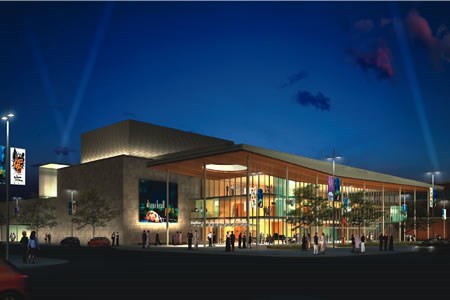A pair of city-driven capital projects worth at least $140 million are beginning to crystallize on Sudbury’s horizon, with the proposed performing arts centre and multi-use recreational complex moving closer to reality.
Preliminary plans have been drawn up for both in anticipation of calculating construction and operational costs in order to ready the two projects for presentation to the city council in the fall. If approved, funding discussions will begin and work will progress.
Due to be located downtown on the corner of Paris and Van Horne, the arts centre is projected to be an 1,800-seat, 85,000-square-foot space. It will feature a main hall, a secondary hall, a large outer lobby as well as any number of interior spaces for offices and rooms for local arts organizations.
The centre is now viewed not only as a standalone effort, but as the nucleus in the creation of an entire arts district. This means that several adjoining blocks will need to be rejuvenated and promoted as a prime location for culturally-focused businesses. Project organizers have already identified several items, including improvement of the Brady Street underpass and various faltering storefronts along Elgin Street.
After five years, the centre could potentially create up to $12.6 million in annual local benefits, as well as 1,000-person-years of employment.
Mark Simeoni, a senior planner with the City of Greater Sudbury, acknowledges there are concerns that the facility may well draw attention away from the adjoining Sudbury Theatre Centre. Officials from the STC have agreed that they’d prefer the arts centre to be closer rather than further away, he says.
"How does it fit into the fibre of the community without ruining it? We’re not there yet; we’re still thinking on it."
The re-imagining of that portion of the downtown as a cluster is key to the eventual success of such a facility, he says. Ticket sales alone are not a sufficiently strong foundation for its economic viability, it would need to draw and feed from the proposed arts district.
As a smaller venue than the Sudbury Arena, but larger than the Laurentian University's Fraser Auditorium, its economic health will not be built upon tourism prospects, says Rob Skelly, city director of tourism. Rather, it would require a strong base of local support to thrive.
Even if the project were to be approved by city council in the fall, the project would require five or six years to come to fruition, Skelly says.
The same timeline would likely apply to the proposed recreational complex, which is slated for the northeast corner of Lasalle Boulevard and Frood Road in the city's North end. This 127-acre, city-owned site would feature three NHL ice pads, an indoor leisure pool, four multi-use playfields and four kilometres of outdoor walking and biking trails,.
This ambitious project would likely improve upon the city’s ability to recruit more skilled workers and medical professionals by offering more healthy living opportunities, says Darren Stinson, chair of the recreational complex project committee.
While no specific projections have been set out, Stinson also adds that a growth in sports tourism could provide an added economic boost to the city. A moderate tournament of 500 participants can bring in as much as $200,000 in direct spending in a weekend.
With big ambition comes a big pricetag. The recreational complex will cost $70 million to build, while related land development costs are under review.
Conversely, the arts centre is now slated to cost $70 million, with $50 million in construction costs, $10 million in "soft costs" such as property acquisition, and $10 million for the surrounding arts district.
Neither set of numbers includes operational costs.
How such projects would be funded, is a question that has yet to be answered. With the city already cash-strapped and its citizens calling for infrastructure improvements, the mayor has suggested the province could cover the lion’s share of the costs.
Provincial and federal funding set aside for arts and culture could be tapped into, not to mention the private sector, says Diane Salo, project chair for the arts centre. Naming rights could be sold for the stage, seats, green room, lobby, and the building itself.
Regardless of costs, Stinson says such projects are necessary for the city’s well-being.
"We’re a big, grown-up city," he says. "We’re not just a mining centre anymore. We need this."




